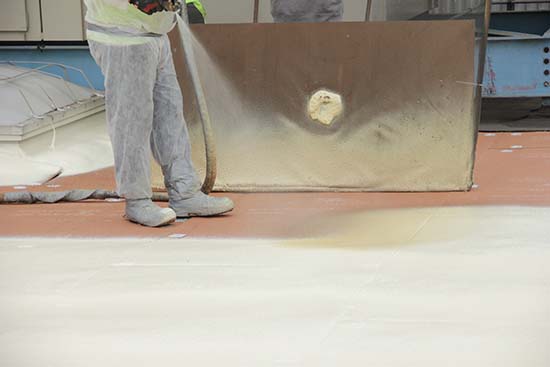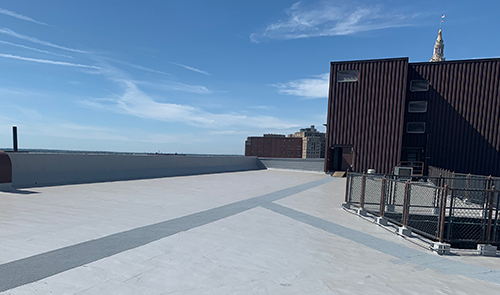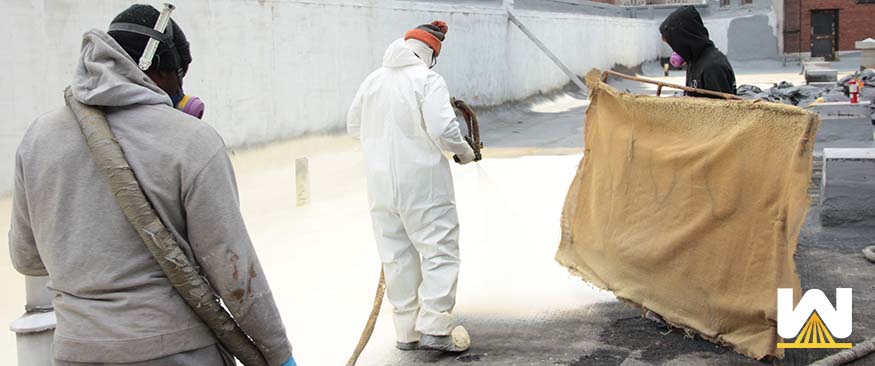Perhaps you’re learning about spray foam roofing for the first time. You hear how it’s seamless, fluid-applied, and in most cases, doesn’t require the existing roof to be removed.
And you wonder, how does the foam attach to an existing roof?
Coming from one of our owners, the short answer is:
“Spray foam is sprayed directly to a clean/prepared surface. Spray foam has tenacious adhesion characteristics and will be fully adhered throughout. There is no need for fasteners for this application.”
Here are some other questions you might have:
- Can I see a video of spray foam adhering to another roofing surface?
- What roofing surfaces can spray foam properly attach to?
- How is a roofing surface prepared before spray foam can be installed?
- What are the benefits of spray foam attaching to an existing roof?
- How strong is spray foam? Can someone walk on it?
And just so you’re aware, West Roofing Systems has been installing spray foam roofing since 1979. We install millions of square feet of spray foam every year.
And lastly, each article written is edited, reviewed, and approved for publication by a spray foam roofing expert with more than 30 years of experience.
Let’s get started!
Can I see a video of spray foam adhering to another roofing surface?
You’ll see the foam lands on a surface, fully adheres to it, and begins to expand. Spray foam needs to be at least 1” thick to maximize performance, but the usual thickness is somewhere between 1-2”, depending on sloping and R-value requirements.
What roofing surfaces can spray foam properly attach to?
Spray foam can properly adhere to:
- Metal
- Granulated Modified
- Smooth Modified
- Smooth built-up
- Gravel built-up
Basically, any roofing surface besides silicone. Nothing sticks to silicone besides silicone.
There are instances, such as with EPDM, TPO, and PVC, where the adhesion is good, but not great. In these cases, a coverboard would be installed over the EPDM, then spray foam would be installed onto the coverboard.
Coverboards are very inexpensive.

How is a roofing surface prepared before spray foam can be installed?
For spray foam to correctly adhere to a surface, that surface needs to be dry, clean, and sound.
Dry
Most roofs are power washed to clean the roof. A roofing contractor needs to make sure the roof is perfectly dry before spraying foam.
If water is on the roofing surface, it can react with the foam, creating an inferior product.
Clean
Any dirt and debris need to be removed from the roof before foam can be applied. The roof should be so clean that even if you dropped your sandwich on the roof, you wouldn’t think twice about picking it up and eating it ?
Sound
“Sound” means that the roofing surface foam is going to go over needs to be fully adhered. Spray foam relies on the existing roof to be 100% adhered to what’s below. Whether that’s insulation, a deck, or another roofing system, it needs to be fully adhered.
An example of a fully adhered substrate is a gravel built-up roof. At every point in the roof, it’s attached to what’s below.
An example of a non-fully-adhered substrate is a TPO roof that was attached to the insulation with plates and fasteners. Usually, these will be installed around the seams only. Therefore, any part of the TPO roof that isn’t around the seams, is not fully-adhered to the insulation below.
What happens if the existing roof isn’t fully-adhered?
In most cases, a coverboard will be installed. A coverboard will provide that fully-adhered substrate for spray foam to attach to.
What are the benefits of spray foam attaching to an existing roof?
With foam being installed over an existing roof, the amount of tear-off is minimized. Sometimes 0% of a roof is torn-off, sometimes it’s 25% of the roof.
The amount that’s ripped off is determined by the condition of the substrate (if it has holes, excessive wear, etc.) and the amount of wet insulation.
Wet insulation should be removed before any roofing system is installed. Sometimes roofing companies will install a roof system over wet insulation to reduce cost. Don’t do this! Problems can happen when the trapped water tries to escape the roof through evaporation. Or the trapped water can freeze, causing issues. Or the water can grow bacteria and mold, causing other issues.
With spray foam minimizing tear-off, the cost is minimized because you don’t have to transfer the existing roof to a landfill. This is good for the environment!
Minimizing tear-off also reduces the time the project takes, which brings the cost of the project down.
NOTE: There are times when you cannot avoid a tear-off, such as when two or more roofing systems are already installed. Building code allows for a maximum of two roofing systems. If you already have two, you must remove one before installing another, whether your roof is in good shape or not.
How strong is spray foam? Can someone walk on it?
The density of the spray foam is designed to allow for foot traffic. Spray foam is denser than commonly used “ISO-Board” in other roof systems.
Spray foam has a compression strength of 50-60 PSI. That’s equivalent to the pegs that your refrigerator sits on.
The PSI for commonly used ISO-Board is around 16-25 PSI.
A sharp object (like heels) can crack a foam roof.
If you’re expecting a large amount of foot traffic, an additional granules broadcast can be installed in designed areas.

Conclusion
Hopefully, you learned how spray foam is attached to an existing roof, the benefits of this application, and how the roof handles foot traffic.
If you’d like to learn more about spray foam roofing, here are other articles that tackle the most commonly asked questions, such as:


